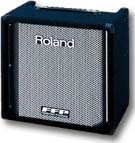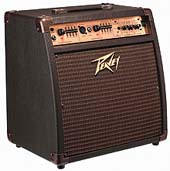Why are there amps designed specifically for electric
guitars, bass guitars, keyboards, drums . . . ? The simple answer
is that amplifying an instrument is not just a matter of taking
a signal from the instrument and making it louder. Different
instruments generate different frequencies or combinations of
frequencies, and an amp is designed to reproduce those
frequencies. But that's only part of it . . . Electric Guitar Amps
For electric guitarists, the way an amp shapes the tone of the
guitar is often just as important as how loud it is. Electric
guitar amps are designed to give the guitar a "new" sound, by
introducing distortion and emphasizing various portions of the
treble and bass ranges. The speakers for an electric guitar amp are also designed to
provide better distortion in the guitar's frequency range.
Bass Amps
A bass amp is designed to reproduce the low frequencies that a
bass guitar puts out and do this with a clean, undistorted
signal. Also, bass amp tone (EQ) controls are designed to
respond to and emphasize bass guitar notes. So can you play your
electric guitar through a bass amp? Yes, but you may not like
the clean, dry, or unbalanced sound you get. Basses are tuned an octave lower than
electric guitars and therefore
require more power to project their lower frequencies. As a
result, a bass amp needs extra power to get the same
apparent loudness as an electric guitar. Bass amp manufacturers
include some awesome "dynamic limiting" circuitry, so
you don't have to worry about overloading the speakers. A
"limiter" keeps the power amp from clipping while
maintaining full power without distorting the signal. Peavey's
"DDT speaker protection," for example, virtually eliminates
distortion. So can you
play your bass guitar through an electric guitar amp? No way!
The bass's lower frequencies can easily overdrive the preamp,
giving you unwanted distortion. And most guitar amp speakers
aren't made to withstand a bass's lower frequencies, so playing
a bass guitar through an electric guitar amp (especially at
higher volume) can blow transistors or even seize the amp
speaker. Acoustic Instrument Amps
Whether you plug in an acoustic guitar, violin, mandolin or
harmonica, an acoustic instrument amp is
designed to deliver the instrument's sound without changing it. Acoustic
instruments are difficult to amplify well. Different frequencies
travel through air at different speeds; amplification changes
those speeds resulting in a sound which differs from the
original. Typically, the closer an amp comes to capturing the
true essence of the acoustic sound, the higher the price. When selecting one,
be sure listen to it
with your own instrument. Features common to acoustic
instrument amps:
- anti feedback -- because of the highly resonant
properties of acoustic instruments, they can feed back into
the amp very easily when playing at high volumes. Feedback
is that painful squealing sound that makes everyone cover
their ears. A built-in "notch filter"
de-emphasizes certain frequencies that tend to create
feedback.
- two channels -- one channel for your instrument and a
Microphone/Aux channel for vocals or an auxiliary source
like a CD player or another instrument.
- EQ -- a 3-band (or more) EQ for each channel. Use the
control knobs (or sliders if it's a graphic EQ) to tailor
the output of the amp for your best sound and to match room
acoustics.
- effects -- some acoustic amps have reverb or a
variety of reverb, delay, chorus, and phaser, allowing players more tone opportunities.
Many acoustic instrument amps amplify the low, mid, and high
sounds separately for less chance of distortion. You'll see
terms like Bi-Amp (2 speakers with 2 dedicated amps) or Tri-Amp
(3 speakers with 3 dedicated amps).
Keyboard Amps
A keyboard amp is designed to reproduce exactly the sound of the
keyboard without coloring the tone. Many of the same design
features in bass guitar amps and acoustic instruments amps are
also found in keyboard amps. If you plan to play more
than one keyboard, then make sure the amp has enough input
channels to accommodate multiple keyboard instruments. |

Bass Guitar Amp

Acoustic Instrument Amp
view large image of
controls
|
|
